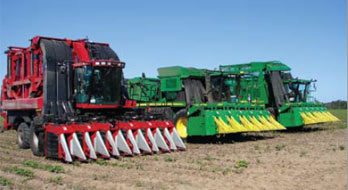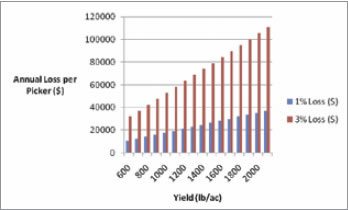The Spindle-Type Cotton Harvester
Introduction
The Need for an Expert Operator


Annual loss resulting from a picker capable of harvesting 8 acres per hour during 220 hours of seasonal operation with cotton lint priced at $1 per pound.

Poor picking efficiency due to hard locks.

Good picking efficiency.
Production of high-quality cotton lint begins with variety selection, continues with attention to all production practices, and ends with a well-planned and well-executed harvest. As harvest time nears, critical crop management decisions include scheduling defoliation, defoliating effectively, and timing harvest to get the best lint quality and yield.
Lint Quality
Lint quality is best when the cotton bolls first open and dry out. Several factors may cause you to lose yield and quality, such as weathering after boll opening, harvest delays caused by poor defoliation or timing, improper machinery adjustment, inadequate picking capacity, harvesting or storage of seed cotton with a high moisture content, storage management that allows weather to wet or damage modules before ginning, etc.
Harvester Factors
Harvester adjustment and operation affects quality and yield. Improper adjustment will reduce quality. For example, poor doffing causes spindle twist. When you do not adjust or operate the harvester properly, you will suffer decreased harvesting efficiency or yield loss. Harvester loss level normally decreases as a percentage of total yield as the yield increases.
Picking Efficiency Losses
Spindle pickers are capable of harvesting 95-98% of the cotton produced, but some producers experience field harvest loss approaching 20%. Several problems can cause picking efficiency losses:
- Row units not centered on the row (driver error or row tracking adjustment)
- Picking too soon after applying defoliants (bolls not open and dried)
- Picking immature crop with bolls that did not open due to early frost or freezing conditions
- Selecting varieties with highly “storm-proof” (less open) bolls
- Compressor door tension and spindle tip clearance not adjusted correctly
- Poor doffer adjustment relative to spindle position
- Worn spindles, spindle bushings, or doffers
- Poor spindle cleaning due to heavy plant buildup (green leaves) or inadequate moistening system adjustment
- Poor doffing (excessive doffer-to-spindle gap, bar heights not correctly adjusted)
- Losses in the handling system
Read Your Operator’s Manual
This information is intended to supplement, not replace, your operator’s manual. Based on years of research, development, and operation, the manual supplies common procedures for successful operation and adjustment. Read and understand the operator’s manual – paying close attention to the safety procedures – before operating your harvester. When you are in doubt or need further clarification, consult the dealer representative or others who are knowledgeable about your machine.









